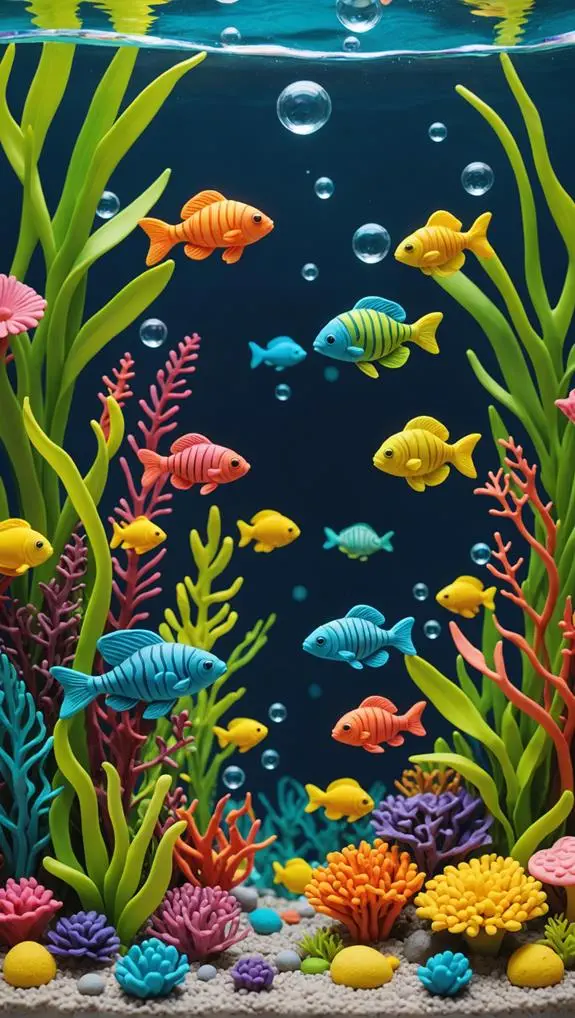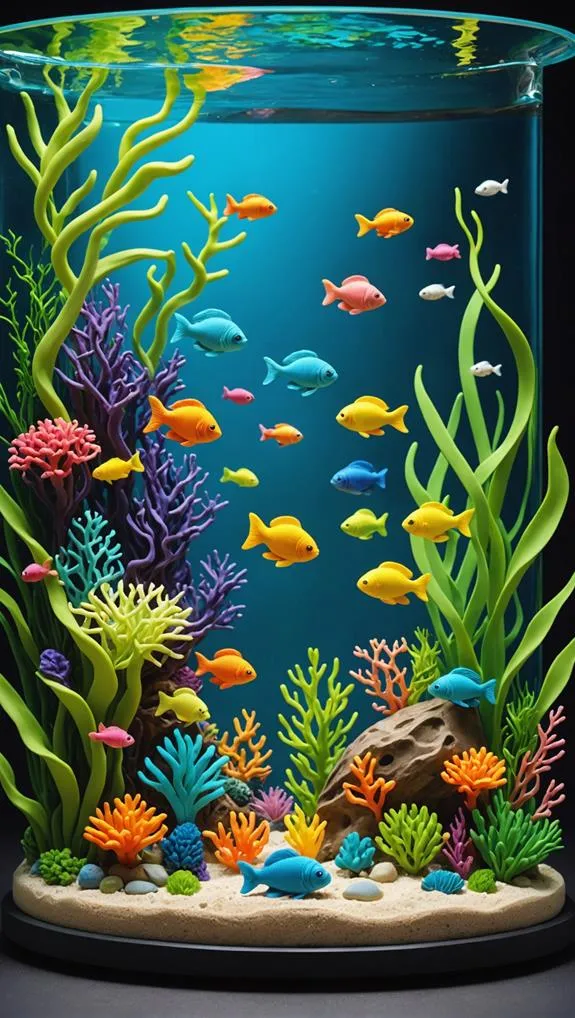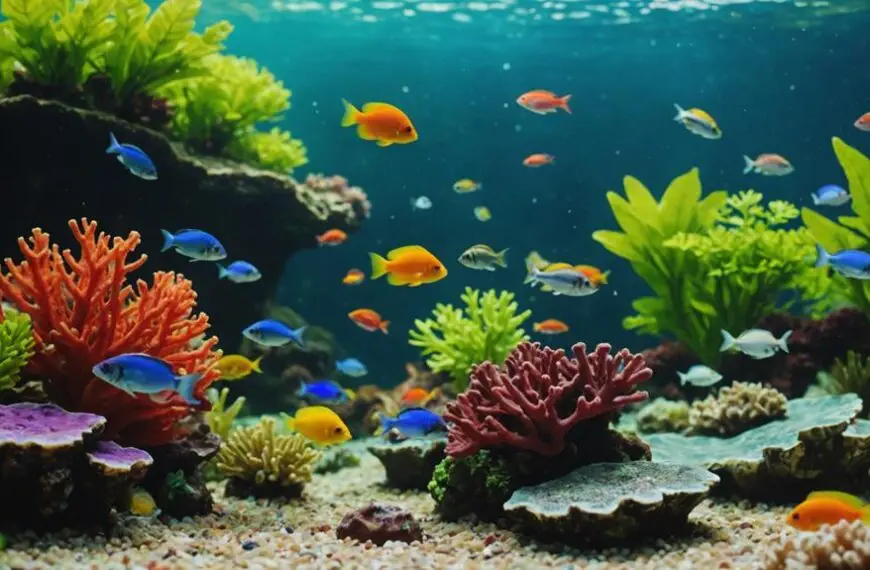Baby fish, or fry, have a big appetite that's crucial for their growth! They thrive on a mix of live foods like baby brine shrimp, infusoria, and even green water, which is just a fancy term for nutrient-rich microalgae. You'll want to feed them small meals 3 to 5 times a day to keep their energy levels up. Those little guys have high metabolisms and need proper nutrients to develop. Just remember to watch their tummies—if they're round, you're doing great! Curious about other essential tips for keeping your fry happy and healthy? You won't want to miss out!
Contents
- 1 Nutritional Needs of Fry
- 2 Types of Suitable Foods
- 3 Benefits of Live Foods
- 4 Preparing Baby Brine Shrimp
- 5 Cultivating Infusoria for Fry
- 6 Advantages of Powdered Foods
- 7 Using Green Water Effectively
- 8 Feeding Frequency and Portions
- 9 Monitoring Fry Health
- 10 Tips for Successful Feeding
- 11 Frequently Asked Questions
- 12 Final Thoughts
Nutritional Needs of Fry
Understanding the nutritional needs of fry is crucial for their healthy development. When you're feeding baby fish, you want to offer them tiny foods that range from 20 to 800 microns. This means options like green water, infusoria, or powdered fry food are your best bets.
Newly hatched fry start their journey relying on the yolk sac for nourishment, but once they're ready, live baby brine shrimp makes for a fantastic first meal. It's important to consider the specific needs of different species; for example, beginner-friendly fish like Betta fish and Platies have unique dietary requirements that can influence the types of food you provide.
You should aim for 3 to 5 small meals daily—yes, that's right! Frequent feeding helps them grow rapidly and thrive. Variety is key, too; mixing it up with crushed flakes or even natural delights like mosquito larvae keeps them happy and healthy, preventing nutritional deficiencies.
While you're monitoring their feeding, check their stomach size. You want to ensure they get enough without overdoing it—overfeeding can mess with your water quality, and nobody wants that!
Types of Suitable Foods
When it comes to feeding baby fish, a variety of suitable foods can significantly impact their growth and health. You want to give your fry the best start possible! One fantastic option is baby brine shrimp. These little swimmers are packed with nutrients and can help your fry grow quickly, usually within 18-36 hours of hatching.
Infusoria is another great choice, especially for those tiny fry. This natural food source consists of microorganisms that are just the right size for their initial feeding stages.
If you're looking for something easy to culture, vinegar eels fit the bill perfectly. They're about 50 microns in diameter and their wiggly motion can attract your fry like a magnet!
Don't forget about green water, too! Composed mainly of microalgae, it's not only nutritious but also helps keep your tank clean.
It's like a two-for-one deal! By mixing these live foods into your fry's diet, you're on the right path to raising healthy and happy little fish. So, roll up your sleeves and get ready to serve up some delicious meals for your aquatic friends!
Benefits of Live Foods

Live foods offer a dynamic and nutritious option for feeding baby fish, making them an essential part of your fry's diet. When you incorporate options like baby brine shrimp, you're giving your little swimmers a treat packed with healthy fats and proteins. Their jerky swimming motion not only tempts the fry but also mimics natural hunting behaviors, promoting faster growth and development.
Additionally, maintaining optimal water quality is crucial, as temperature fluctuations can affect the overall health and metabolism of your fry, impacting their feeding efficiency and growth rates temperature influences water quality.
Choosing a variety of live foods is key. For instance, infusoria is perfect for the tiniest fry, while vinegar eels provide a delightful wiggle that keeps your little ones engaged. This variety helps prevent nutritional deficiencies and nurtures their overall well-being. You wouldn't want your fry to miss out on essential nutrients, right?
Plus, feeding live foods like microalgae and live worms can boost their immune systems, resulting in a healthier, more robust population. It's like giving your fish a vitamin-packed buffet!
Preparing Baby Brine Shrimp
Preparing baby brine shrimp is easier than you might think, and it's a fantastic way to nourish your fry!
All you need to do is soak the eggs in salt water, keep the temperature just right, and give them some aeration for about 18 to 36 hours.
Not only do these tiny swimmers pack a nutritional punch with essential fats and proteins, but their lively movement will have your little fishies excited for mealtime!
Hatching Process Details
To hatch baby brine shrimp (BBS), you need to soak the eggs in salt water with a salinity of around 1.020-1.025.
Make sure the water's well-aerated and kept at a cozy temperature between 74-82°F (23-28°C). It usually takes about 18-36 hours for those little eggs to hatch, depending on their quality and your environmental setup.
Once they're ready, you'll notice these tiny foods measuring around 400-500 microns, perfect for feeding the fry! Their jerky swimming motion makes them irresistible, encouraging those little fish to show off their natural hunting skills.
When it's time to harvest, grab a fine mesh net or siphon, and gently collect the BBS without causing too much ruckus in the hatching container.
This process isn't just about feeding; it's about nurturing your fish fry with the best possible start. Watching them chase after those tiny shrimp can be a delight, reminding you how important these little meals are in their growth journey.
Nutritional Benefits for Fry
Baby brine shrimp (BBS) offer numerous nutritional benefits that can significantly boost the health and growth of your fry. These tiny swimming wonders are packed with higher protein levels, which is essential for the rapid development of newly hatched brine shrimp.
When you feed your fry this fish food, you're not just filling their bellies; you're giving them the vital nutrients they need to thrive.
The jerky swimming motion of BBS naturally entices your tiny fry, encouraging their instinct to hunt. It's like a mini buffet ready to stimulate their feeding behaviors. Plus, BBS has a rich yolk sac filled with healthy fats and proteins, promoting vitality and energetic growth, which is crucial during those early days.
To get the best survival rates, remember that hatching BBS requires proper saltwater soaking, aeration, and a cozy water temperature of 74-82°F.
In just 18-36 hours, you'll have a fresh supply of these nutritious snacks ready to boost your fry's chances of thriving. So, roll up your sleeves and dive into the world of baby brine shrimp; your little fishy friends will thank you for it!
Cultivating Infusoria for Fry

When it comes to feeding your baby fish, cultivating infusoria is a game-changer!
These tiny microorganisms are perfect for those little fry, and setting up a culture is easier than you might think.
Just grab an old jar, some tank water, and a bit of organic matter, then watch your miniature buffet grow—who knew fish food could be so simple and fun?
Infusoria Culture Setup
Creating a successful infusoria culture is essential for providing nutritious food for your fry.
You'll want to start by filling a jar with some old tank water. Next, add a source of organic matter—think decomposing leaves or even powdered fish food. This combination creates a cozy home for those tiny infusoria to thrive.
To really get the party started, keep the culture at tropical water temperatures, ideally between 74-82°F (23-28°C). In about one to two weeks, you'll have a thriving food source, perfect for your small fry.
When it's time to harvest, use a pipette or turkey baster to scoop up some of that rich, scummy goodness just below the surface. This is where the infusoria density is at its peak!
And don't forget: keep topping off your culture with fresh tank water and adding more organic material. This helps maintain those infusoria populations, ensuring your fry always have a steady supply of food.
With a bit of patience and care, you'll be nurturing healthy fry in no time. Happy culturing!
Harvesting Techniques Explained
Harvesting infusoria effectively ensures your fry get the nutrition they need to thrive. These tiny microorganisms are the perfect food for baby fish, thanks to their small mouth size. To collect infusoria, start by using a jar filled with old tank water and some organic matter, like dead leaves or vegetable scraps. This setup creates a cozy environment for your little critters, so keep it warm—tropical temperatures work best!
When it's time to harvest, grab a pipette or turkey baster. Just dip below the surface scum where you'll find a concentrated zone of infusoria, ready to feed your fry. It's like fishing without the rod!
Regularly topping off your culture with fresh tank water and adding more organic matter can keep your infusoria thriving longer, ensuring a steady food supply for your growing fish.
Infusoria is a natural food source that promotes growth and health in your fry, acting as a bridge until they're ready for larger meals.
Advantages of Powdered Foods
The versatility of powdered foods offers significant advantages for feeding baby fish, ensuring they receive the right nutrition at every stage of growth. These finely-ground options cater to fry of various sizes, ranging from 5-800 microns. This means you can find the perfect fit for your little swimmers, promoting healthier development and preventing nutritional deficiencies.
Additionally, incorporating high-quality flakes or pellets into their diet can support vibrant colors and overall health, which is particularly important for species like guppies and bettas that thrive on a diverse diet essential fish care tips.
Popular brands, like Hikari First Bites and Spirulina powder, are specially formulated to meet the unique dietary needs of fry, enhancing their growth rates and overall vitality. You'll love how easy it's to provide dietary variety, keeping your baby fish happy and healthy.
One important tip? Use a paintbrush to control portions and avoid overfeeding. Too much food can lead to poor water quality, which is a situation no one wants to deal with!
Mixing powdered foods with live options can yield optimal growth rates, making your fry flourish like aquatic superstars.
Using Green Water Effectively

Utilizing green water can be a game-changer for feeding baby fish, as it provides a rich, natural food source packed with nutrients. This nutritious food primarily consists of microalgae and phytoplankton, which are fantastic for enhancing your baby fish's growth and vitality.
To cultivate green water, fill a container with old tank water, toss in some organic matter, and let it soak up continuous light for 24 hours. This will promote algal growth like nobody's business!
Don't forget to regularly agitate the surface; it boosts oxygen exchange and helps those microalgae thrive, making it the perfect fry diet.
When it's time to harvest, use a siphon or net to gently collect the upper layers, where the concentration of microalgae is highest. This way, you'll keep your algae culture happy and healthy.
Incorporating green water into your baby fish's diet not only stimulates their natural foraging behavior but also acts as a natural purifier, maintaining water quality. So, go ahead and embrace green water—your baby fish will thank you with their lively antics!
Plus, who doesn't love a little green in their tank?
Feeding Frequency and Portions
Feeding baby fish requires attention to frequency and portion sizes to ensure optimal growth and health. These little fry have a high metabolism and tiny stomachs, so you'll want to feed them small amounts multiple times a day—ideally 3 to 5 times.
In their first couple of weeks, they rely on their yolk sac, but as they grow, it's crucial to introduce external foods. When you do, watch their stomachs closely. You want them adequately filled but not bloated—overfeeding can lead to serious issues, including poor water quality. A handy trick is to use a paintbrush for powdered foods; it helps control portions while reducing waste.
Mix things up with a variety of foods! Incorporating live baby brine shrimp and infusoria can enhance their nutritional intake, making those little fins stronger and healthier.
Monitoring Fry Health

Keeping a close eye on your fry's health is just as important as feeding them properly. You want to ensure they're thriving in their little underwater world. Here are four key aspects to monitor:
- Monitor stomach size: After feeding, check if their bellies are comfortably rounded, not bulging. This ensures they're eating enough without overdoing it.
- Watch water parameters: Keep an eye on nitrate levels, ideally below 40 ppm. This helps prevent stress and keeps your fry swimming happily.
- Observe for healthy development: Look for signs like increased size and developing pigmentation, especially within the first two weeks. These are good indicators of growth!
- Check swimming patterns: Active swimming and exploration are signs your fry feel safe and healthy in their environment.
Don't forget to perform regular water changes and maintain a clean tank environment. This reduces the risk of diseases that can impact your fry's health.
Tips for Successful Feeding
How can you ensure your baby fish get the nutrition they need for healthy growth? Start by offering a variety of foods! Live foods, like baby brine shrimp and infusoria, are fantastic options. They're packed with nutrients and help your little swimmers grow strong.
It's best to feed them multiple times a day—aim for 3 to 5 small portions daily, especially during the first two weeks.
You can also introduce powdered fry food, like Hikari First Bites. This stuff is perfect for tiny tummies and helps prevent overfeeding, which can mess with your water quality. Speaking of which, always monitor feeding closely. Check your fry's stomachs after meals; they shouldn't look like they just ate a Thanksgiving feast!
Don't forget about natural food sources too! Green water and microworms can provide ongoing nutrition while helping your fry learn to forage.
Think of it as a buffet that keeps them entertained and healthy. By mixing things up and keeping an eye on their feeding habits, you'll set your baby fish up for a happy, healthy life. They'll thank you with their joyful little wiggles!
Frequently Asked Questions
What Do Baby Fish Eat in a Tank?
In a tank environment, you ensure baby fish nutrition by providing live food, like brine shrimp, and maintaining water quality. Remember to feed them frequently for optimal fish growth and health in their delicate stages.
What Food to Give Baby Fish?
Did you know baby fish grow twice as fast with the right nutrition? For optimal baby fish nutrition, offer beginner fish food multiple times daily, incorporating nutritional supplements to support growth stages in a balanced tank environment.
Will Baby Fish Survive in My Tank?
Your baby fish can survive in your tank if you ensure suitable tank conditions, maintain water quality, consider tankmates compatibility, avoid predator species, and monitor their growth rates and breeding habits carefully.
How Do You Feed Baby Fish at Home?
To feed baby fish at home, use effective feeding techniques like providing small nutrition sources several times daily. Monitor water quality and adjust feeding frequency to support optimal fish growth in a healthy tank environment.
Final Thoughts
Feeding baby fish in your tank can feel like hosting a tiny dinner party. You've got to whip up the right menu, and every morsel counts! From live foods to green water, each option helps those little fry grow strong and vibrant. Keep an eye on their health, and don't forget to adjust portions as they munch away. With a little care, you'll see your fish thrive, turning your tank into a lively underwater community. Happy feeding!












